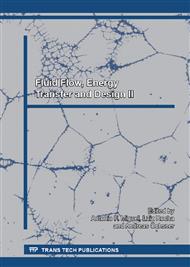[1]
Simon H., Nahas G., Coulon N., Air–steam leakage through cracks in concrete walls, Nuclear Engineering and Design, Volume 237, Issues 15–17, September 2007, Pages 1786-1794, ISSN 0029-5493.
DOI: 10.1016/j.nucengdes.2007.03.025
Google Scholar
[2]
Gelain T., Vendel J., Research works on contamination transfers through cracked concrete walls, Nuclear Engineering and Design, Volume 238, Issue 4, April 2008, Pages 1159-1165.
DOI: 10.1016/j.nucengdes.2007.08.007
Google Scholar
[3]
Rastiello, G., et al. Real-time water permeability evolution of a localized crack in concrete under loading., Cement and Concrete Research 56 (2014): 20-28.
DOI: 10.1016/j.cemconres.2013.09.010
Google Scholar
[4]
Bear J., Chin-Fu T., and De Marsily G. Flow and contaminant transport in fractured rock. Academic Press, (1993).
Google Scholar
[5]
Roubinet, D., Liu H. -H., and J. -R. de Dreuzy (2010), A new particle-tracking approach to simulating transport in heterogeneous fractured porous media, Water Resour. Res., 46, W11507.
DOI: 10.1029/2010wr009371
Google Scholar
[6]
Dormieux, Luc, and Djimedo Kondo. Approche micromécanique du couplage perméabilité–endommagement., Comptes Rendus Mécanique 332. 2 (2004): 135-140.
DOI: 10.1016/j.crme.2003.11.003
Google Scholar
[7]
Drugan, W. J., and J. R. Willis. A micromechanics-based nonlocal constitutive equation and estimates of representative volume element size for elastic composites., Journal of the Mechanics and Physics of Solids 44. 4 (1996): 497-524.
DOI: 10.1016/0022-5096(96)00007-5
Google Scholar
[8]
Stroeven, M., H. Askes, and L. J. Sluys. Numerical determination of representative volumes for granular materials., Computer Methods in Applied Mechanics and Engineering 193. 30 (2004): 3221-3238.
DOI: 10.1016/j.cma.2003.09.023
Google Scholar
[9]
Auriault, J-L. Upscaling heterogeneous media by asymptotic expansions., Journal of engineering mechanics 128. 8 (2002): 817-822.
DOI: 10.1061/(asce)0733-9399(2002)128:8(817)
Google Scholar
[10]
Secchi, S., and B. A. Schrefler. A method for 3-D hydraulic fracturing simulation., International journal of fracture 178. 1-2 (2012): 245-258.
DOI: 10.1007/s10704-012-9742-y
Google Scholar
[11]
Jaffré J, and Roberts J. E. Modeling flow in porous media with fractures; Discrete fracture models with matrix-fracture exchange., Numerical Analysis and Applications 5. 2 (2012): 162-167.
DOI: 10.1134/s1995423912020103
Google Scholar
[12]
Lesinigo, Matteo, Carlo D'Angelo, and Alfio Quarteroni. A multiscale Darcy–Brinkman model for fluid flow in fractured porous media., Numerische Mathematik 117. 4 (2011): 717-752.
DOI: 10.1007/s00211-010-0343-2
Google Scholar
[13]
Adler R. Some new random field tools for spatial analysis. Stochastic environmental research and risk assessment, 22, 809-822 . (2008).
DOI: 10.1007/s00477-008-0242-6
Google Scholar
[14]
Bogdan M. Morphological modeling of cement based materials and hydration process, Conference proceedings, Microstructural-related Durability of Cementitious Composites, Amsterdam Netherlands. (2012).
Google Scholar
[15]
Rahli, O., Bennacer, R., Bouhadef, K., & Ameziani, D. E. (2011). Three-dimensional mixed convection heat and mass transfer in a rectangular duct: case of longitudinal rolls. Numerical Heat Transfer, Part A: Applications, 59(5), 349-371.
DOI: 10.1080/10407782.2011.549081
Google Scholar
[16]
Leonard B.P. and Mokhtari S., Beyond first order upwinding: the ULTRA-SHAP alternative for non-oscillatory steady-state simulation of convection, Int. J. Numerical Methods Eng., Vol. 30, pp.729-766, (1990).
DOI: 10.1002/nme.1620300412
Google Scholar
[17]
Patankar S.V., Numerical Heat Transfer and Fluid Flow, Mc Graw-Hill, New York, 1980. (Book).
Google Scholar
[18]
Stone, H.L. Iterative solution of implicit approximations of multi-dimensional partial differential equations, SIAM J. Numer. Analysis, Vol. 5, pp.530-558, (1968).
DOI: 10.1137/0705044
Google Scholar
[19]
Leong W.H., Hollands K.G. and Brunger A.P., Experimental Nusselt numbers for a cubical-cavity benchmark problem in natural convection, Int. J. Heat Mass Transfer, 42, 1979 (1999).
DOI: 10.1016/s0017-9310(98)00299-3
Google Scholar
[20]
Mossad R., Prediction of natural convection in an air-filled cubical cavity using FLUENT Software, in: ICHMT 2nd Int. Symp. Adv. in Comp. Heat Transfer, Palm Cove, Australia, Begell House, Inc., New York, 1, 1371 (2001).
Google Scholar
[21]
Krepper E., Validation exercise: natural convection in an air-filled cubical cavity, in: ICHMT 2nd Int. Symp. Adv. in Comp. Heat Transfer, Palm Cove, Australia, Begell House, Inc., New York, 1, 1351 (2001).
Google Scholar
[22]
Xia C., Murthy J.Y. and Mathur S.R., Finite-volume computations of buoyancy-driven flow in a cubical cavity: a benchmarking exercises, in: ICHMT 2nd Int. Symp. Adv. in Comp. Heat Transfer, Palm Cove, Australia, Begell House, Inc., New York, 1, 1345 (2001).
Google Scholar
[23]
Mimouni N., Bennacer R., Chikh S., and Rahli O., Limitation of parallel flow in double diffusive convection: Two- and three-dimensional transitions in a horizontal porous domain, Physics of Fluids 26, 074105 (2014).
DOI: 10.1063/1.4886801
Google Scholar
[24]
Jaballah S., Sammouda H., Bennacer R., Study of the mixed convection in a channel with porous layers using a thermal nonequilibrium model. Journal of Porous Media . Vol 15. Num 1. Pages 51-62. (2012).
DOI: 10.1615/jpormedia.v15.i1.40
Google Scholar


